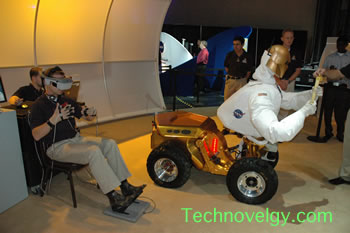While it might be just a single step for this robot, it’s really a giant leap forward for tinmankind,” said Rob Ambrose, acting chief of Johnson Space Center’s automation, robotics and simulation divisionSpace is about to get its first humanoid from planet Earth. Robonaut 2 - affectionately known as R2 - is hitching a one-way ride to the International Space Station this week aboard the final flight of space shuttle Discovery.
It’s the first humanoid robot ever bound for space, a $2.5 million mechanical and electrical marvel that NASA hopes one day will assist flesh-and-bone astronauts in orbit.
Imagine, its creators say, a future where Robonaut could take over space station cleaning duties; spend hours outside in the extreme heat and cold, patiently holding tools for spacewalking astronauts; and handle emergencies like toxic leaks or fires.
Why, Robonaut’s descendants could even scout out asteroids, Mars and other worlds in the decades ahead, paving the way for humans.
The adventure begins Wednesday afternoon, with the planned final launch of Discovery and Robonaut’s six human crewmates. Mission managers gave the green light Monday for the new launch date; shuttle gas leaks had to be repaired before the countdown could begin and forced a two-day delay.
“While it might be just a single step for this robot, it’s really a giant leap forward for tinmankind,” said Rob Ambrose, acting chief of Johnson Space Center’s automation, robotics and simulation division in Houston.
For now, R2 - a collaboration between NASA and General Motors - exists only from the waist up. It measures 3 feet 4 inches (1 meter) tall and weighs 330 pounds. Each arm is 2 feet (0.6 meters) 8 inches (20 centimetres) long. Legs are still in the works. But, oh, what an upper body- perfectly toned arms and hands with palms, a robotic rarity, along with broad shoulders and a washboard stomach. Arnold Schwarzenegger, Hollywood’s cyborg Terminator, would be proud. Watch Robonaut lifting a 20-pound (9-kilogram) dumbbell, and “you can kind of feel the burn,” Mr. Ambrose said, showing a video at a recent news conference. Unlike people who tend to cheat, “this robot will really do what the physical trainers tell you to do, which is to do the bicep curls nice and slow,” he said.
The depth and breadth of human performance is beyond the current state of the art in robotics, NASA targeted the reduced dexterity and performance of a suited astronaut as Robonaut's design goals, specifically using the work envelope, ranges of motion, strength and endurance capabilities of space walking humans.


No comments:
Post a Comment